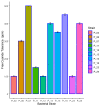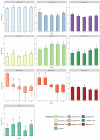Effect of Lyoprotective Agents on the Preservation of Survival of a Bacillus cereus Strain PBG in the Freeze-Drying Process
- PMID: 38004717
- PMCID: PMC10673073
- DOI: 10.3390/microorganisms11112705
Effect of Lyoprotective Agents on the Preservation of Survival of a Bacillus cereus Strain PBG in the Freeze-Drying Process
Abstract
Lyophilization is a widely employed long-term preservation method in which the bacterial survival rate largely depends on the cryoprotectant used. Bacillus cereus strain PBC was selected for its ability to thrive in environments contaminated with arsenic, lead, and cadmium, tolerate 500 ppm of free cyanide, and the presence of genes such as ars, cad, ppa, dap, among others, associated with the bioremediation of toxic compounds and enterotoxins (nheA, nheB, nheC). Following lyophilization, the survival rates for Mannitol 2.5%, Mannitol 10%, and Glucose 1% were 98.02%, 97.12%, and 96.30%, respectively, with the rates being lower than 95% for other sugars. However, during storage, for the same sugars, the survival rates were 78.71%, 97.12%, and 99.97%, respectively. In the cake morphology, it was found that the lyophilized morphology showed no relationship with bacterial survival rate. The best cryoprotectant for the PBC strain was 1% glucose since it maintained constant and elevated bacterial growth rates during storage, ensuring that the unique characteristics of the bacterium were preserved over time. These findings hold significant implications for research as they report a new Bacillus cereus strain with the potential to be utilized in bioremediation processes.
Keywords: bacterial survival; glucose; lactose and Bacillus; lyophilization; mannitol.
Conflict of interest statement
The authors declare no conflict of interest.
Figures







Similar articles
-
Cytotoxicity of the Bacillus cereus Nhe enterotoxin requires specific binding order of its three exoprotein components.Infect Immun. 2010 Sep;78(9):3813-21. doi: 10.1128/IAI.00247-10. Epub 2010 Jul 12. Infect Immun. 2010. PMID: 20624910 Free PMC article.
-
Complex formation between NheB and NheC is necessary to induce cytotoxic activity by the three-component Bacillus cereus Nhe enterotoxin.PLoS One. 2013 Apr 30;8(4):e63104. doi: 10.1371/journal.pone.0063104. Print 2013. PLoS One. 2013. PMID: 23646182 Free PMC article.
-
Characterization of the Bacillus cereus Nhe enterotoxin.Microbiology (Reading). 2004 Dec;150(Pt 12):3959-67. doi: 10.1099/mic.0.27359-0. Microbiology (Reading). 2004. PMID: 15583149
-
Genetic and genomic diversity of NheABC locus from Bacillus strains.Arch Microbiol. 2017 Jul;199(5):775-785. doi: 10.1007/s00203-017-1350-9. Epub 2017 Mar 10. Arch Microbiol. 2017. PMID: 28283680 Free PMC article.
-
An overview of liposome lyophilization and its future potential.J Control Release. 2010 Mar 19;142(3):299-311. doi: 10.1016/j.jconrel.2009.10.024. Epub 2009 Oct 27. J Control Release. 2010. PMID: 19874861 Review.
Cited by
-
Effectiveness of Lyoprotectants in Protein Stabilization During Lyophilization.Pharmaceutics. 2024 Oct 21;16(10):1346. doi: 10.3390/pharmaceutics16101346. Pharmaceutics. 2024. PMID: 39458674 Free PMC article. Review.
References
-
- Karn R., Ojha N., Abbas S., Bhugra S. A Review on Heavy Metal Contamination at Mining Sites and Remedial Techniques. IOP Conf. Ser. Earth Environ. Sci. 2021;796:012013. doi: 10.1088/1755-1315/796/1/012013. - DOI
-
- Chandran H., Meena M., Sharma K. Microbial Biodiversity and Bioremediation Assessment Through Omics Approaches. Front. Environ. Chem. 2020;1:570326. doi: 10.3389/fenvc.2020.570326. - DOI
-
- Jones D.L., Rowe E.C. Encyclopedia of Applied Plant Sciences. Volume 2. Elsevier; Amsterdam, The Netherlands: 2017. Land Reclamation and Remediation, Principles and Practice; pp. 304–310.
Grants and funding
LinkOut - more resources
Full Text Sources
Miscellaneous

